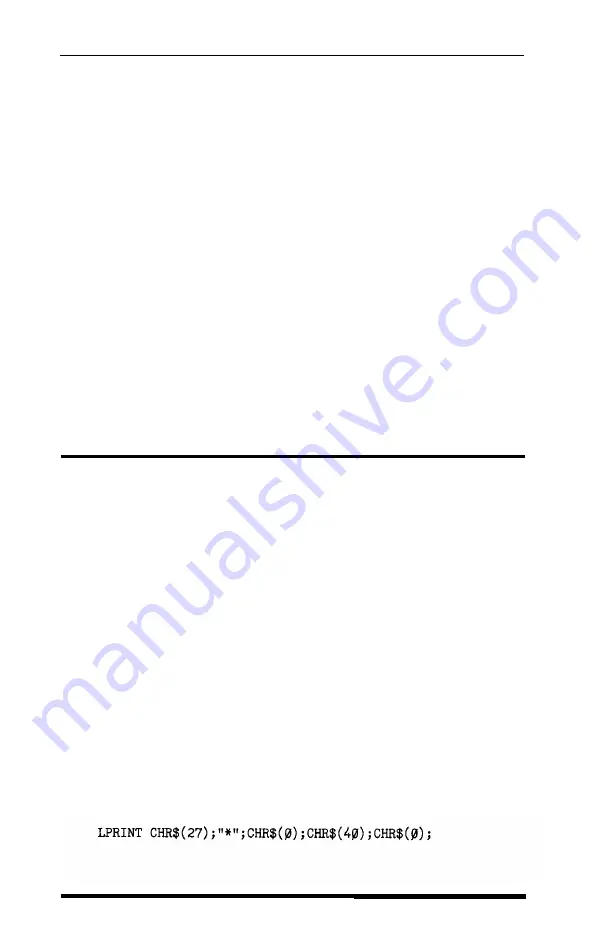
1. The computer is prevented from adding any extra characters by the
WIDTH statement (line 100).
2. The line spacing is changed to 8/72 of an inch-the height of the
dot patterns used in the program (fine 110).
3. The program goes through the graphics commands the required
number of times (fines 120 and 170).
4. A new graphics command is used for each line printed (lines
130-160). This part of the program is similar to the last example, but
two columns are printed each time through the loop making a total
of 100.
5. The last important thing to do is to reset the printer to its default
settings, including the normal line spacing (fine 180).
Notice that the graphics command (ESC K) can be in effect for only
one print line. To print more than one line of graphics, the graphics
command must be issued before each line.
Density Varieties
Although all the examples so far in this chapter have been in the
singledensity graphics mode, there are six other eight-pin densities and
two that use all nine pins. Nine-pin graphics is not necessary for most
uses, but you can find the command (ESC ˆ) in the Epson mode
command summary
The four most common eight-pin modes are available in both Epson
and IBM printer emulation modes. Their commands are ESC K, ESC L,
ESC Y, ESC Z. In Epson mode, there is also a general-purpose command
for any of the eight-pin graphics modes: ESC *. This command is used
in the same way as the individual commands, except that before
nl
and
n2
you must send the code for the graphics mode required. The
different modes are summarized in the table on the next page.
The following example shows how to use the ESC * command to
reserve 40 columns for singledensity graphics. This uses mode number
0 from the table to achieve exactly the same effect as the first example
using ESC K.
6 - 8
Graphics
and User-defined Characters
Summary of Contents for EX-1000
Page 1: ......
Page 11: ......
Page 29: ...1 18 Setting Up the Printer ...
Page 38: ......
Page 46: ...3 8 Using the EX with Application Programs ...
Page 51: ......
Page 57: ...5 6 EX Printer Features ...
Page 76: ......
Page 81: ...Command Summary A 5 ...
Page 82: ...A 6 Command Summary ...
Page 121: ......
Page 123: ...Table B 1 Epson mode characters B 2 Character Tables ...
Page 124: ...Table B 1 continued Character Tables B 3 ...
Page 125: ...Table B 1 continued B 4 Character Tables ...
Page 126: ...Table B 1 continued Character Tables B 5 ...
Page 127: ...Table B 1 continued B 6 Character Tables ...
Page 128: ...Table B 1 continued Character Tables B 7 ...
Page 129: ...Table B 1 continued B 8 Character Tables ...
Page 133: ...Table B 4 IBM printer emulation mode characters B 12 Character Tables ...
Page 134: ...Table B 4 continued Character Tables B 13 ...
Page 135: ...Table B 4 continued B 14 Character Tables ...
Page 137: ...Table B 4 continued B 16 Character Tables ...
Page 139: ...Table B 4 continued B 18 Character Tables ...
Page 151: ...D 8 Problem Solving and Maintenance ...
Page 157: ...E 6 Defaults and DIP Switches ...
Page 172: ......
Page 173: ...G 8 Technical Specifications ...
Page 183: ...IN 4 Index ...
Page 184: ...Quick Reference ...
Page 186: ......
Page 187: ......
Page 188: ......
Page 189: ......
Page 190: ......






























